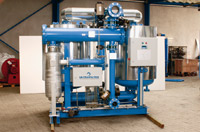Ultra.dry heat regenerated adsorption dryer
The value of dry and clean compressed air
In nearly all areas of the industry compressed air is one of the indispensable sources of energy. The application of working, conveying, measuring, controlling and regulating air is just as important as the application in the process technology. The atmospheric inlet air of the compressor contains harmful substances and impurities. Moisture in the form of vapour is condensed out into the compressed air network. This causes expensive damage and a loss in quality. Therefore, processing concepts consisting of filtration and drying are an integral part of every compressed air application.
The drying method is determined by the application. Where very low residual moisture is a requirement in respect of pressure dewpoints below 0°, adsorption drying is applied.
- high energy efficiency
- high reserve capacity reliability
- safe operation
- easy maintenance
- service friendly
Quality products made in Germany
In order to produce heat regenerated adsorption dryers, only components that meet the highest quality standards of production are used. The Quality Assurance system according to ISO 9001 means that all appliances receive the "Quality Product" certification. In combination with the maintenance-friendly and user-friendly construction, absolute reliability and security of operation is ensured.
Energy Save Adsorption dryers made by Ultrafilter without compressed air losses
Based on the standard HRS- models, the HRS-L version is designed for processing requirements at tropical and subtropical ambient conditions. These conditions do not allow for cooling with fresh air. The characteristic feature of the HRS models is a closed loop cooling ( Loop-Version ). A water-cooled heat exchanger cools the air stream heated by the desiccant. From there the cooling air is led back to the inlet port of the blower. For all worldwide climate zones this version offers a pressure dew point of -70°C.
Heat of Compression Dryers

The most economical and energy saving adsorption dryer is heat of compression . Which utilises the hot air from an oil free compressor to release the moisture out of the regeneration adsorption vessel. By using the hot air after the compression process no additional energy is required to regenerate the adsorption dryer.
Universal technology
As with all externally heated adsorption dryers the desorption of the moisture adsorbed in the desiccant of the HRE models takes place with the heated blower air stream. The cooling of the desiccant is conducted with partial flow of the already dried compressed air. Because the cooling process is independent of the ambient conditions HRE models can be used worldwide.
High energy saving
The HRG models, designed according to the existing concept, also belong to the family of blower air regenerated adsorption dryers. The ambient air drawn in by the blower cools the desiccant that was heated during the desorption phase. Thus, compressed air is not used during the desorption or cooling phases.
Pressure-Vacuum-Regeneration
Adsorption Phase
For HRS units the moisture-containing compressed air flows via the inlet fitting through the desiccant bed. While passing the desiccant bed the water vapour is adsorbed by the hygroscopic adsorbent. The dried compressed air is now discharged into the compressed air network.
Desorption phase without consumption of compressed air
Whilst the adsorption takes place in the one vessel, the other is regenerated. Before the regeneration starts the pressure in the vessel to be regenerated is slowly reduced down to atmospheric pressure. Desorption of the HRS system is conducted with inlet ambient air. A blower compresses the ambient air to regeneration pressure. The temperature increase due to the compression has a positive effect on the energy requirement of the downstream heater. The heater heats up the blower air to the required desorption temperature. The blower air flows in a counter current into the adsorber where it is desorbed and evaporates the water contained in the desiccant.
Cooling without consumption of compressed air
The adjacent cooling of the heated desiccant takes place with ambient air. The feature of the HRS system variation is that after completion of the desorption phase, the blower switches over to vacuum operation. The cool ambient air takes up the heat from the desiccant and via the blower it is conveyed to the atmosphere. The vacuum that occurs during the cooling phase causes a reduction of the desorption temperature. Therefore residual water content in the desiccant is reduced during the cooling cycle. The advantage of the vacuum cooling is the improved regeneration of the desiccant. Consequently with the same energy consumption the vacuum cooling achieves a better quality, respectively at the same quality heat energy is saved.




